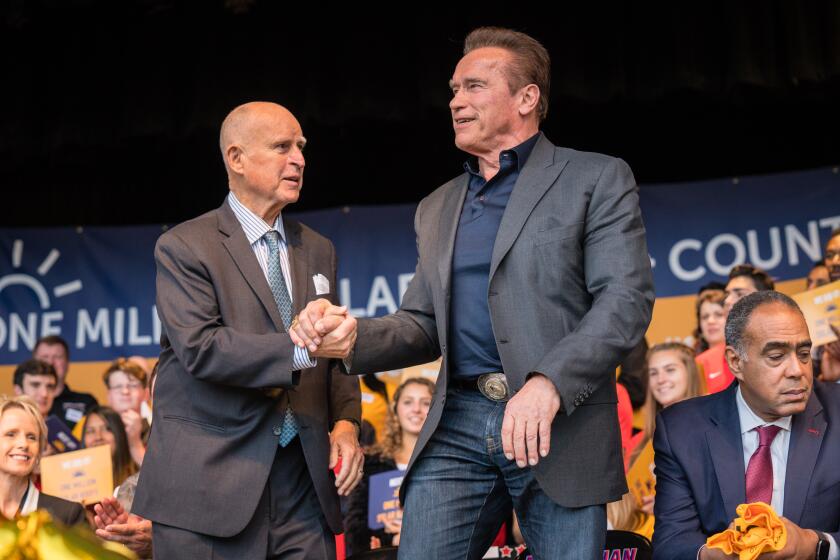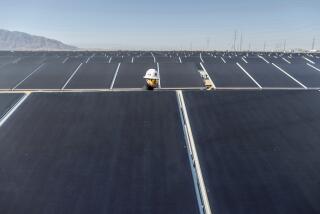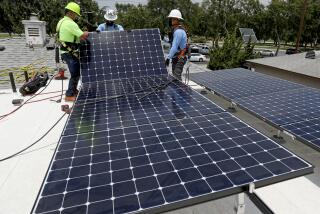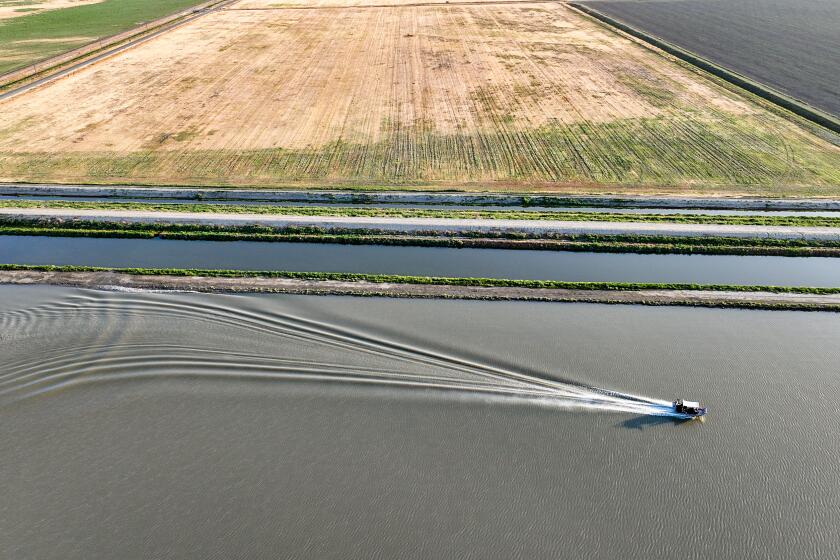Trump administration says it will approve largest U.S. solar farm
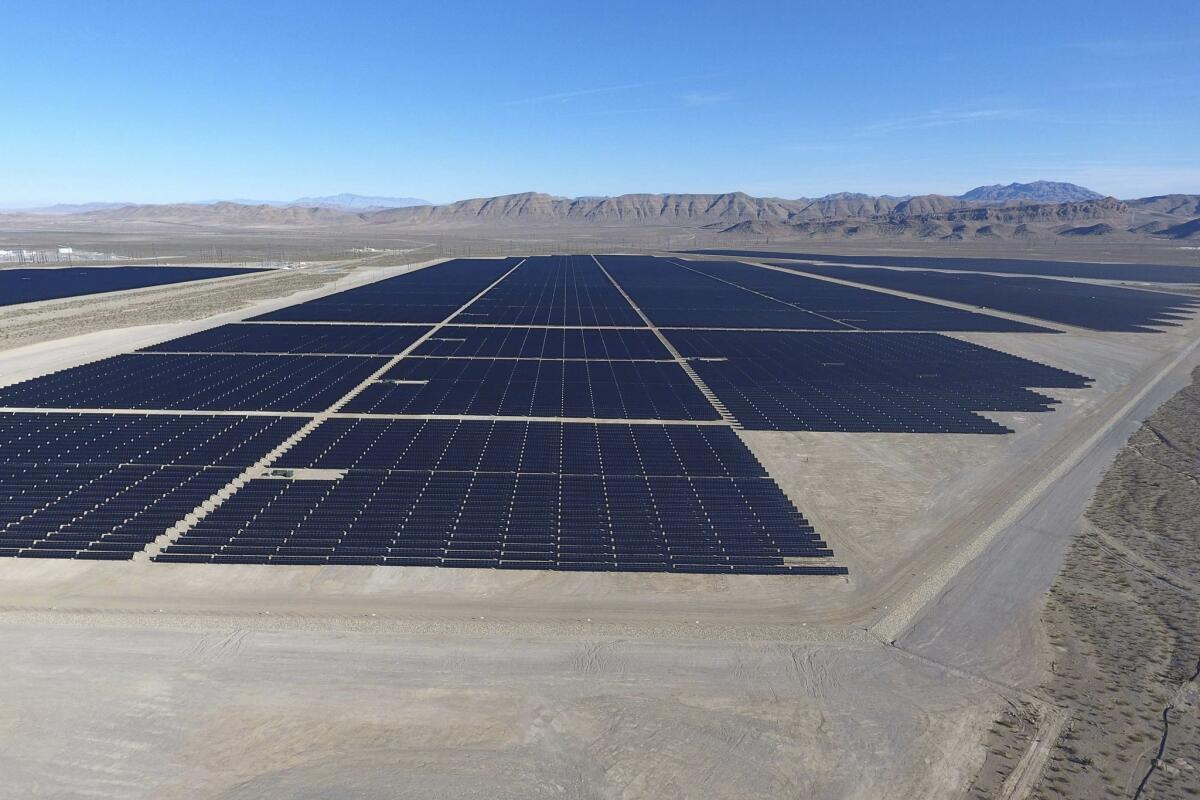
Federal officials plan to approve a massive solar farm with energy storage in the desert outside Las Vegas, paving the way for a $1-billion project that will provide electricity to Nevada residents served by billionaire Warren Buffett’s NV Energy.
At 690 megawatts across 7,100 acres, the facility would generate more power than the largest solar farm currently operating in the United States, a 579-megawatt plant in Southern California. The energy storage component — at least 380 megawatts of four-hour lithium-ion batteries, capable of storing solar power for use after dark — would also be one of the largest facilities of its kind.
For the record:
2:29 p.m. Jan. 1, 2020Due to a calculation error in the original project documents, an earlier version of this article misstated the expected cost of what NV Energy will pay for the combined output of the solar panels and batteries as $42.83 per megawatt-hour.
The so-called Gemini project will be on federal lands and thus requires sign-off from the Interior Department. The department’s Bureau of Land Management released a final environmental impact statement Monday, in which federal officials indicated they would approve the project after one last round of public comments, likely within 90 days.
President Trump has rejected mainstream climate science, attempted to roll back dozens of regulations affecting the fossil fuel industry and routinely criticized renewable energy. In March he called solar power “very, very expensive” despite the fact that it’s now the cheapest electricity source across much of the United States, and in December he once again exaggerated the threat posed to bald eagles by wind turbines.
But Trump’s appointees at the Interior Department have shepherded several large renewable energy projects across the finish line.
Gemini could be the third solar farm on public lands approved by federal officials since Trump took office, joining the 80-megawatt Sweetwater project in Wyoming and the 500-megawatt Palen project in California’s Riverside County.
The Bureau of Land Management published the final environmental analysis for another large Riverside County solar project, Desert Quartzite, in September, but has not yet issued an official “record of decision.”
The Gemini project “would represent a significant increase in renewable energy capacity for Nevada and the West,” Tim Smith, the bureau’s district manager for southern Nevada, said in a recent news release, when the project’s draft environmental analysis was released.
“The BLM actively supports the Department of the Interior’s America First Energy Plan, an ‘all of the above’ strategy which supports energy development on public lands,” Smith said.
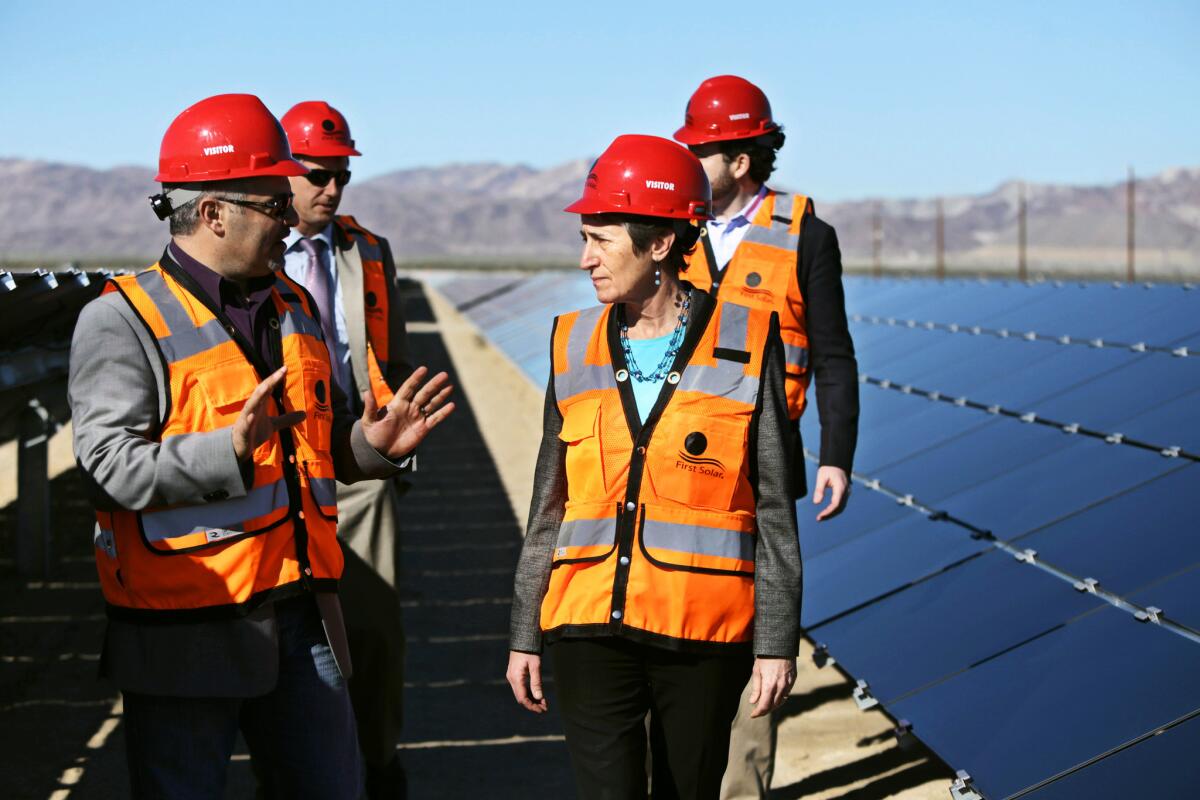
The Trump administration has also issued several approvals for the Chokecherry and Sierra Madre wind project, which is being developed in Wyoming by Philip Anschutz, the billionaire owner of Staples Center and the Coachella Valley Music & Arts Festival. If fully built out, it would be the largest wind farm in the country, with 1,000 turbines capable of producing 3,000 megawatts of power.
Falling prices and supportive state policies have continued to drive demand for renewable energy, even with the Trump administration taxing imported solar panels and more recently rejecting a proposed extension for clean energy tax credits.
The investment bank Lazard reported in Novemberthat onshore wind and solar power are two of the cheapest sources of new electricity generation in the United States, averaging $28 per megawatt-hour and $36 per megawatt-hour, respectively. Electricity from a new natural gas plant, by comparison, typically costs $44 to $68 per megawatt-hour, according to Lazard.
The Eland solar contract had been delayed due to concerns raised by the city electrical workers union.
NV Energy will pay an average of $38.44 per megawatt-hour for the combined output of the solar panels and batteries at the Gemini project under a 25-year contract.
The addition of Gemini and two other solar-plus-storage projects “allows us to extend the benefits of renewable energy to times when the sun is not shining,” Doug Cannon, NV Energy’s president and chief executive, said last month.
“Today’s decision brings the environmental and price benefits of low-cost solar energy to our customers,” Cannon said in a news release, after the Public Utilities Commission of Nevada approved power purchase contracts for Gemini and the other projects. “We are proud to be delivering a renewable energy vision to our customers that also supports Nevada’s economic and sustainability goals.”
In Nevada, as in California, lawmakers have approved policies promoting climate-friendly energy.
A bill signed by Nevada Gov. Steve Sisolak last year required utilities to get half of their electricity from renewable sources by 2030, and set a goal of 100% zero-carbon electricity by 2050. NV Energy, which is owned by Buffett’s Berkshire Hathaway Energy and is the state’s largest power provider, estimated that 24% of its electricity came from renewables in 2018.
The Gemini project is being developed by Quinbrook Infrastructure Partners and Arevia Power, and is expected to be fully operational by Dec. 1, 2023. It will be built along Interstate 15 about 30 miles northeast of Las Vegas, near two large solar farms that are already operating on the other side of the freeway.
Gemini “will demonstrate the ability to couple solar PV technology with battery storage to capture and use Nevada’s abundant renewable solar resource to deliver low cost power to NV Energy’s customers and keep the lights on long after the sun has set,” Quinbrook co-founder David Scaysbrook said in a news release in early December.
“We believe Nevada is an ideal location for a project of this magnitude,” Scaysbrook said.
Like many large-scale renewable energy projects proposed in the desert southwest, Gemini has faced opposition from conservationists concerned about the effects on natural ecosystems and undeveloped landscapes. Those critics typically support renewable energy but say solar panels on rooftops and parking lots should be prioritized, with large-scale projects limited to degraded lands.
Clean energy advocates are talking about what comes next — and warning that climate change demands faster action.
Nonprofit groups including Defenders of Wildlife, the National Parks Conservation Assn. and the Sierra Club pointed out in comment letters that the Bureau of Land Management’s environmental analysis of the Gemini solar farm estimates the project’s construction and operation could result in the deaths of up to 215 adult desert tortoises.
“There is no justification for this project that outweighs the importance of the desert tortoise, its habitat and BLM’s obligations to use its full authority to take actions that will contribute to the recovery of this threatened species,” Jeff Aardahl, a biologist with Defenders of Wildlife, wrote in September.
The Palen solar project in California faced similar criticisms before it was approved by the Trump administration in 2018. The project from EDF Renewable Energy will be just outside Joshua Tree National Park. CleanPowerSF, the community choice agency that provides electricity to San Francisco, said recently it would buy 100 megawatts of power from Palen.
In California, state and federal officials tried to resolve the conflict between energy development and conservation by crafting the Desert Renewable Energy Conservation Plan, which protected millions of acres of public lands while setting aside smaller areas for solar and wind farms. But the Trump administration said in 2018 that it would reopen the Obama-era plan, with a stated goal of paving the way for more renewable energy projects.
So far, federal officials haven’t announced any changes to the desert plan. The Bureau of Land Management didn’t respond to a question this week about the status of its review.
In a written statement, BLM spokesman Jeff Krauss said the agency “supports an all-of-the-above energy approach, which includes oil and gas, coal, strategic minerals, and renewable energy resources such as wind, geothermal and solar — all of which may be developed on public lands and subject to free markets.”

